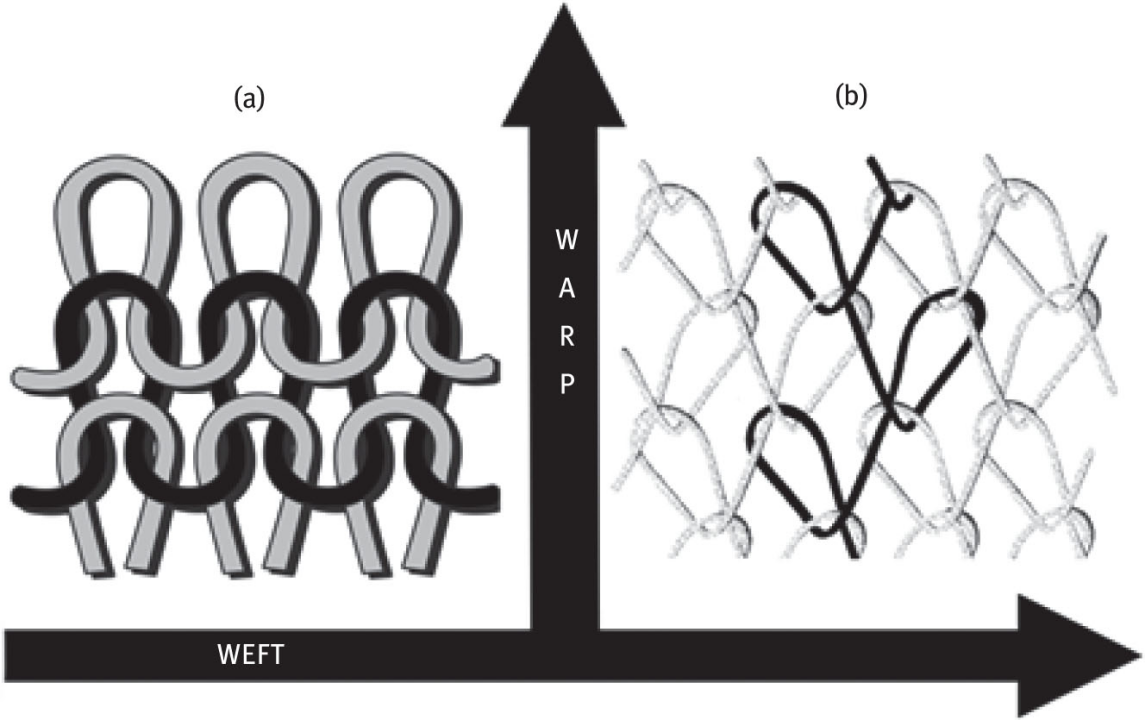Weave Method
Aug 25,2022 | normtex
Divided by weave method
It may be produced by several techniques, the most common of which are weaving, knitting, bonding, felting, or tufting.
Weaving
The woven fabrics are produced by interlacing two sets of yarns perpendicular to each other
, warp and weft. The first set includes the threads running lengthwise in the fabric, while the second is represented by the threads placed in a cross or width direction. The fabrics have varying structures, depending on the interlacement pattern of the yarns. This sequence of interlacements is termed as the weave design of the fabric. The properties of the fabric are governed by its weave design as well as the fiber content used as the raw material.

The interlacement of warp and weft produces the woven fabric, and this interlacement pattern is called the weave design of the fabric. The three basic weave designs are plain, twill and satin.

Plain
The simplest interlacing pattern for warp and weft threads is over one and under one. The
weave design resulting from this interlacement pattern is termed plain or 1 / 1 weave. The 1 / 1 interlacement of yarns develops more crimp, and the fabric produced has a tighter structure. The plain weave is produced using only two Heald frames. Plain weave variations include warp rib, weft rib, and matt or basket weave.
Twill
This weave is characterized by diagonal ribs (twill line) across the fabric. It is produced in a stepwise progression of the warp yarn interlacing pattern. The interlacement pattern of each warp starts on the next filling yarn progressively. The two subcategories based on the orientation of twill lines are Z- and S-twill or right-hand and left-hand twill, respectively. Some variations of twill weave include pointed, skip, and herringbone twill.
Satin / Sateen
The satin/sateen weave is characterized by longer floats of one yarn over several others. The satin weave is warp-faced, while sateen is a weft-faced weave. A move number is used to determine the layout in a weave repeat of satin, and the number of interlacements is kept to a minimum. The fabrics produced in satin weaves are more lustrous than corresponding weaves.
Table 1 Comparison between woven and knitted fabrics, machine, and proces
|
|
Parameter |
Woven Fabric |
Knitted Fabric |
|
1 |
Process requirement |
Fabric requires two sets of yarn for interlacement, one is warp and other is weft yarn. |
Fabric can be produced from a single end or a cone of a yarn in case of weft knitting. |
|
2 |
Dimensional stability |
More stable |
Less stable. Careful handling is required for knitted fabric during wet processing and stitching. |
|
3 |
Comfort |
Less comfort due to tight structure |
More open spaces that give better air permeability and moisture management |
|
4 |
Shape retention properties |
Woven garments retain their own shape |
Knitted garments get the shape of the wearer’s body, hence, best for undergarments |
|
5 |
Crease resistant |
Poor crease resistance |
High crease resistance
|
|
6 |
Development route |
Yarn preparation requires warping, sizing drawing, etc. |
Fabric can be produced from yarn packages. So process route is very short |
|
7 |
Conversion cost |
Conversion from yarn to fabric involves various processes. The conversion cost is higher. |
Conversion requires no preparation, so conversion cost is low |
|
8 |
Environmental effect |
Preparation includes sizing of warp yarn that must remove before color application, that may cause environmental pollution |
The yarn is just waxed. No need to size the yarn, so development cause fewer environmental hazards |
Knitting
Knitting is fabric formation technique in which the yarn is bent into loops and those loops are interconnected to form fabrics. Knitting can be defined in simple words as the interloping of adventure. The bending of yarn provides better stretchability, extensibility, comfort, and shape retention properties. However, they tend to be less durable than woven fabric.
The knitted fabric can be categorized into two significant classes i., e., warp, and weft knitting, on the basis of yarn feeding and the direction of movement of yarn in fabric concerning the fabric formation direction.

Weft Knitting
Weft-knit fabric is familiar for its comfort and shape retention properties. The fabric can be produced from a single end. The movement of yarn in the weft direction provides stretchability in both directions that could be engineered to achieve the required properties. The apparels, either inner or outerwear, are the most demanding area of weft-knit fabric. This technique is further classified into different machine types and structures.
Circular knitting machines are particularly used to produce tubular fabric. Circular machines are classified into three major categories based on cylinder and Dial. In the first category, where the device has only one cylinder, needles are placed inside the cylinder trick that moves up and down for loop formation. Popular structures are single jersey and their derivatives.
The second type of machine has both dials and cylinders. The needles are placed in both the dial and cylinder. The cylinder needles move up and down while the dial needle moves in to and fro. The major machine types are Rib and Interlock. The difference in their construction is the placement of tricks or grooves. The grooves on the Rib machine of both dial and cylinder are alternative to each other, whereas, on interlock, the grooves are opposite.
The third class is Purl, in which the machine has two cylinders. These cylinders are superimposed. The purl fabric is also known as link-link fabric. The needle is hocked on both sides. The same hand is placed in opposite tricks of these cylinders. The flat machines can produce both single and double-knit fabrics.
Warp Knitting
Warp knitting may be defined as the loop formation process along the warp direction of the fabric. The simultaneous yarn sheet is provided to the machine along the warp direction for the loop formation process. The sheets of yarn are supplied from warp beams as in weaving. Each warp end is provided to each individual needle. The same yarn runs along the warp direction, and the needle draws the new loop yarn through the old loop that was formed by another yarn in the previous knitting cycle. Each yarn also passes through the guide mounted on the guide bar that provides the movement of the same yarn between the needles.
The warp knitting machines are flat, and the fabric formation technique is more complex than weft knitting.
Table 2 Comparison of warp and weft knitting.
|
Weft Knitting |
Warp Knitting |
|
|
1 |
Individual yarn is provided to the feeder. If a machine has 90 feeders and all are active, then 90 courses are inserted in a complete revolution. |
Simultaneous sheets of yarn are fed to the machine. The number of ends required will be equal to the number of needles on the machine. |
|
2 |
Loop formation along the weft or course direction of the fabric. |
Loop formation along the wale or |
|
3 |
The yarn is supplied in the form of |
Yarn supplied to machine from warp |
|
4 |
The spun yarns are mostly the raw |
The filament yarn is used in |
|
5 |
The weft-knitted fabric has less |
The warp-knitted fabric is |
|
6 |
The weft-knitted fabric is more |
The warp-knitted fabric is less |
|
7 |
Latch needle is preferably used in |
Latch as well as bearded and |
|
8 |
The application of weft-knitted fabric is mostly apparel including both outer and inner garments. |
The application area of warp-knitted fabric is not only apparel but also have huge demand for domestic, industrial, and technical applications. |



